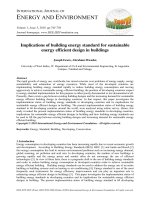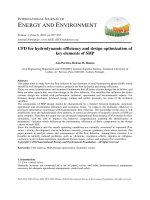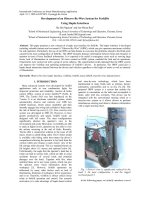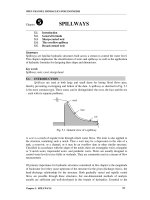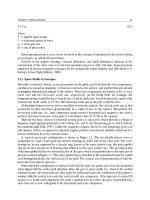Column Generation for WDM Optical Network Design pptx
Bạn đang xem bản rút gọn của tài liệu. Xem và tải ngay bản đầy đủ của tài liệu tại đây (226.42 KB, 25 trang )
Column Generation for WDM
Column Generation for WDM
Optical Network Design
Optical Network Design
S. Raghavan
Daliborka Stanojević
Robert H. Smith School of Business, University of Maryland, College
Park
Simpo PDF Merge and Split Unregistered Version -
Outline
• Basic concepts
• Problem Definition
• Background
• Branch-And-Price (BP) Algorithm
– Column Generation (CG)
– Branching Strategy
• Preliminary Computational Results
• Concluding Remarks
Simpo PDF Merge and Split Unregistered Version -
optical fiber
Basic Concepts
in WDM optical network design
• Optical fibers interconnect
nodes in the network
optical fiber
• WDM – multiple signals
carried over the same fiber
at different frequencies
(wavelengths)
1
λ
2
λ
3
λ
Simpo PDF Merge and Split Unregistered Version -
Basic Concepts
in WDM optical network design
Node Equipment
• Single signal example
A DC B
intermediate nodes (no E/O
O/E conversion necessary)
signal origin node signal destination node
Transmitter - - Receiver
• Assumption: All nodes are equipped with wavelength
converters ⇒ we do not have to worry about
wavelength assignment (so, signal A → B could be sent
on different wavelengths on each of the segments A →
C, C → D, D → B)
Simpo PDF Merge and Split Unregistered Version -
Basic Concepts
in WDM optical network design
Notion of lightpaths and logical topology
•Def: Lightpath (lp) is a path in the physical topology used to
carry traffic requests. It requires a transmitter at the path origin,
and a receiver at the path destination (lps in the example: A →
B, A → C, B → D)
•Def: Logical Topology is a collection of all lps established
in the physical layer of the optical network.
A
D
C
B
- Transmitter
- Receiver
- Fiber with
capacity of 1 TU
Traffic requests
:
A → B 0.3 TU’s
A → C 0.9 TU’s
A → D 0.2 TU’s
Simpo PDF Merge and Split Unregistered Version -
Problem Definition
• Given physical topology of the WDM optical network:
– Number and capacity of fibers
– Capacity of lightpaths that can be created on the fibers
– Number of transmitters and receivers at each node
– Traffic matrix (demand between all pairs of nodes)
• Determine logical topology (routing of lightpaths over the
physical topology) and routing of traffic flow over the
logical topology so that network performance is optimized.
Simpo PDF Merge and Split Unregistered Version -
Additional Assumptions
• No flow bifurcation for a given traffic request
• Wavelength conversion is possible (at no cost) at all
nodes in the network
• Performance measures considered:
– Lost traffic
– Quantity / cost of node equipment
– Average hop distance over all flow paths in the network
Simpo PDF Merge and Split Unregistered Version -
Background
• Exact MIP formulations for WDM OND problem are
too difficult to solve
– Banerjee and Mukherjee (2000) - WDM OND with
wavelength conversion (problems solved include networks
with up to 20 nodes, at most 1 fiber between pairs of nodes,
and pre-specified set of lightpaths)
– Krishnaswamy and Sivarajan (2001) – WDM OND without
wavelength conversion (problems solved include networks
with up to 6 nodes)
• Large number of heuristic algorithms – an extensive
survey – Dutta and Rouskas (2000)
Simpo PDF Merge and Split Unregistered Version -
Background
• The WDM OND problem with wavelength conversion
can be seen as a 2-layer ODI MCF problem with node
degree constraints – a generalization of a standard ODI
MCF problem
• ODI MCF problem can be efficiently solved in
networks of moderate size using branch and price and
cut algorithm – Barnhart et al. (2000)
Simpo PDF Merge and Split Unregistered Version -
Path-based formulation for the WDM
OND problem
•PB-MIP1
),(1
0
);,(
:
),(),(
:
),(),(
);,(:
)(:
)(:
),(
),(),(
dsHf
zfTX
ljiLX
VjX
ViX
toSubject
HTMin
ds
p
ds
p
pzp
ds
p
ds
z
zljiz
z
jzDz
j
rz
izOz
i
tz
ds
dsds
∀=+
∀≥−
∀≤
∈∀∆≤
∈∀∆≤
∑
∑
∑
∑
∑
∑
∈
∈
=
=
∀
zRX
dszfX
sconstraAdditional
zBX
dspBf
z
pzp
ds
pz
z
ds
p
∀∈
∀≥−
∀∈
∀∈
+
∈
∑
1
:
),(
1
1),(
),(,0
int
),(,
Simpo PDF Merge and Split Unregistered Version -
Path-based formulation for the
WDM OND problem
•PB-MIP2
zGX
zgGYfT
ljidLYfT
VjbYfT
ViaYfT
vdualtoSubject
HTMin
zz
zzz
pzpds
ds
p
ds
zljiz
ljiz
zljipzpds
ds
p
ds
j
jzDz
j
rz
jzDpzpds
ds
p
ds
i
izOz
i
tz
izOpzpds
ds
p
ds
ds
dsds
∀=+
∀=++
∀≤+
∈∀∆≤+
∈∀∆≤+
∑
∑∑
∑∑
∑∑
∑
∈∀∀
∈∈∈∀∀
==∈∃∀
==∈∃∀
∀
1
1
);,(
.:
:),,(
),(),(
);,(:
);,(
);,(::),,(
),(),(
)(:)(::),,(
),(),(
)(:)(::),,(
),(),(
),(
),(),(
zRX
dszvfX
sconstraAdditional
zZX
dspBf
dswHf
zrfTX
z
z
pzp
ds
pz
z
ds
p
dsds
p
ds
p
ds
z
pzp
ds
p
ds
z
∀∈
∀≥−
∀∈
∀∈
∀=+
∀≥−
+
∈
+
∈
∑
∑
∑
1
:
),(
1
1),(
),(),(),(
),(
:
),(),(
),(,0
int
),(,
)
,(1
0
Simpo PDF Merge and Split Unregistered Version -
Column Generation for PB-MIP2
• Reduced cost for any flow path variable is:
• To identify potential new flow paths we can solve the
following problem for each commodity:
•Or
• Can be solved as a shortest path problem in a graph
with edges represented by lightpaths and edge costs
defined by term
),(),(),(),(
);,(
);,(
),(),(),(
)(
ds
pz
z
dsds
zz
ds
zlji
lji
ds
j
ds
i
ds
wvTrgTdTbTaT −++−−−−
∑
∑
∈∀∈∀
∑
∑
∈∀∈∀
∀
++−−−−
pz
z
dsds
zz
ds
zlji
lji
ds
j
ds
i
ds
z
vTrgTdTbTaTMin )((*)
),(),(),(
);,(
);,(
),(),(),(
∑
∈∀
∀
pz
dsz
z
PMin
),(,
),(, dsz
P
Simpo PDF Merge and Split Unregistered Version -
Column Generation (cont.)
SOLUTION:
• For any new lightpath z, the term can be reduced to:
• As we are looking for new lightpaths that will minimize the
term , we can solve the following for each pair of
nodes:
or
• Can be solved as an all-pair shortest path problem with
edge costs defined by
),(, dsz
P
∑
∈∀
−−−
zlji
lji
ds
j
ds
i
ds
dTbTaT
);,(
);,(
),(),(),(
),(, dsz
P
∑
∈∀
−−−
zlji
ljiji
dbaMin
);,(
);,(
}{
∑
∈∀
−
zlji
lji
dMin
);,(
);,(
}{
lji
d
);,(
−
Simpo PDF Merge and Split Unregistered Version -
Column Generation – main steps
Solve restricted
master problem
For all
commodities
(s, d)
Using costs computed in the
previous 2 steps, find the shortest
path for commodity (s, d)
Compute Pz,(s,d) for all z already
in the model
Length of SP <
w(s,d)?
Any new lightpaths
used in the SP?
Add new flow path
variables
Add new lps and
corresponding constraints
Reduced cost
nonnegative for
all commodities?
LP solved
Compute Pz,(s,d) for all z not in
the model by solving the all-pair
SP problem
Yes
Yes
Yes
No
No
No
Simpo PDF Merge and Split Unregistered Version -
Branching Strategy
• Efficient branching strategy for ODIMCF problem (Barnhart
et al.):
– Identify 2 fractional paths for the fractional flow with greatest
demand and create 2 children nodes using the following rule:
– Let A be a set of arcs originating at divergence node (D). Define 2
subsets of arcs A1 and A2, such that E ∈ A1, F ∈ A2, |A1| ≈
|A2|, A1∩ A2 = Ø, and A1 ∪ A2 = A.
– Create one child node that does not use any arcs in set A1, and
one child node that does not use any arcs in set A2
– Important property: Proposed branching strategy does not
destroy the structure of the pricing problem.
A DC B
F
E
Simpo PDF Merge and Split Unregistered Version -
Branching Strategy (cont.)
• Since a single flow path in the WDM OND problem may
visit the same node more than once, we cannot apply
similar branching strategy.
Example
• Solution: Apply branching strategy that prohibits use of
certain arcs only for specific lightpaths of a given
commodity
A DC B
F
E
Flow path A →B
using lps:
A →F {A, C, D, F}
F →B {F, D, E, B}
Simpo PDF Merge and Split Unregistered Version -
Branching Strategy (cont.)
• Step 1. Check if there are any commodities with fractional
traffic. If there is no such commodity go to Step 4.
• Step 2. Identify commodity with greatest demand that has
fractional lost traffic.
• Step 3. Create 2 new nodes:
– Node 1: Set H
(s,d)
= 1
Do not serve demand for commodity (s,d) in the final solution
– Node 2: Set H
(s,d)
= 0
Serve demand for commodity (s,d) in the final solution
Simpo PDF Merge and Split Unregistered Version -
Branching Strategy (cont.)
• Step 4. Identify 2 paths with the greatest fractions of flow
for commodity (s, d) selected in Step 1.
• Step 5. If the 2 selected flow paths do not differ in the
logical layer, go to Step 7.
• Step 6. Locate divergence node in the logical layer and
create 2 new nodes (by first identifying 2 disjoint and
exhaustive sets of lightpaths emanating from divergence
node)
– Node 1: for commodity (s, d) forbid all lps in the first set of arcs
– Node 2: for commodity (s, d) forbid all lps in the second set of
arcs
Simpo PDF Merge and Split Unregistered Version -
Branching Strategy (cont.)
• Step 7. Locate divergence node d in the physical layer, and
identify wavelengths l1 and l2 on fibers originating at node
d that are being used by flow paths identified in Step 2.
• Step 8. Identify origin and destination of the lp (say O’→D’)
corresponding to wavelenghts and fibers identified in Step
7.
• Step 9. Create 2 new nodes:
– Node 1: If l1 and l2 are on different fibers do not allow allow
commodity (s, d) to use any lps O’ →D’ that use fiber l2 belongs
to. Otherwise, do not allow commodity (s, d) to use any lps O’
→D’ that use l2.
– Node 2: If l1 and l2 are on different fibers do not allow allow
commodity (s, d) to use any lps O’ →D’ that use fiber l1 belongs
to. Otherwise, do not allow commodity (s, d) to use any lps O’
→D’ that use l1.
Simpo PDF Merge and Split Unregistered Version -
Applicability of the proposed BP algorithm to
WDM OND with alternative design objectives
• Only minor modifications in computation of reduced
cost are necessary when considering alternative
design objectives, such as:
– Quantity / cost of node equipment
– Average hop distance over all flow paths in the network
• Overall Column Generation Algorithm and the
Proposed Branching Strategy remain valid in all
cases
Simpo PDF Merge and Split Unregistered Version -
Preliminary Computational Results
Node Nbr Commodity Nbr Demand LB UB cpu (seconds)
5 20 H 0.11 0.73 0.516
5 20 L 0 0 0.188
5 10 H 0 0 0.109
5 10 L 0 0 0.094
7 42 H 4.018* 5.38 803.594
7 42 L 0 0.87 743.685
7 21 H 0.19 0.7 1.16
7 21 L 0 0.12 0.611
10 90 H 21.098* 23.18 4782.41
10 90 L 5.402* 8.22 4577.11
10 45 H 2.46* 4.1 3797.63
10 45 L 0 0.35 3617.45
20 380 H 152.451 155.44 2233.76
20 380 L 70.74 86.84 2587.49
20 190 H 52.794 57.29 2434.47
20 190 L 17.277 32.8 2280.26
Table 1. Minimizing lost traffic. Complete network with 2 fibers (fiber
capacity: 2 lightpaths) between all pairs of nodes, 3 transmitters and 3
receivers at each node. Demand H: uniformly random [0.1, 1], L: uniformly
random [0.1, 0.5].
Simpo PDF Merge and Split Unregistered Version -
Preliminary Computational Results
Node Nbr Com modity Nbr Demand LB UB cpu (seconds)
5 20 H 23.825* 28 48.516
5 20 L 16.439* 20 29.781
5 10 H 15.002* 16 3.015
5 10 L 11.57* 14 6.891
7 42 H 51.521* 62 3796.53
7 42 L 35.340* 42 3678.02
7 21 H 26.457* 32 55.922
7 21 L 18.658* 22 59.797
10 90 H 112.596* 134 5646.34
10 90 L 75.637* 180** 3149.42
10 45 H 56.666* 68 4076.89
10 45 L 39.248* 50 3926.81
Table 2. Minimizing total number of transmitters and receivers in the
network. Complete network with 2 fibers (fiber capacity: 2 lightpaths)
between all pairs of nodes. Demand H: uniformly random [0.1, 1], L:
uniformly random [0.1, 0.5].
Simpo PDF Merge and Split Unregistered Version -
Concluding Remarks
• Proposed Column Generation Algorithm for the WDM
optical network design can be used to test optimality of
solutions provided by existing heuristic procedures
• Application of the proposed procedures to WDM optical
network design with alternative design objectives requires
only minor modifications
• Efficiency of the proposed BP algorithm may be
significantly improved by resolving degeneracy issue.
Simpo PDF Merge and Split Unregistered Version -
References
• D. Banerjee and B. Mukherjee. Wavelength-routed optical
networks: Linear formulation, resource budgeting tradeoffs,
and a reconfiguration study. IEEE/ACM Transactions on
Networking, 8(5): 598-607, 2000
• C. Barnhart, C. A. Hane, and P. H. Vance. Using branch
and price and cut to solve origin-destination integer
multycommodity flow problems. Operations Research,
48(2):318-326, 2000
• R. Dutta and G. N. Rouskas. A survey of virtual topology
design algorithms for wavelength routed optical networks.
Optical Networks Magazine, January 2000
Simpo PDF Merge and Split Unregistered Version -
References (cont.)
• R. M. Krishnaswamy and K. N. Sivarajan. Design of logical
topologies: A linear formulation for wavelength-routed
optical networks with no wavelength changers. IEEE/ACM
Transactions on Networking, 9(2): 186-198, 2001
Simpo PDF Merge and Split Unregistered Version -
